Arizona's Border Strike Force isn't what Gov. Doug Ducey claimed, data shows
- Oops!Something went wrong.Please try again later.
The Border Strike Force has been a favored talking point of Gov. Doug Ducey. It featured prominently in his reelection bid in 2018. And it was used as a talking point again in 2022, as border security became an issue for Republicans in that election cycle.
But according to records obtained by the Arizona Republic after a legal battle with the Department of Public Safety, the Border Strike Force is a misnomer.
For one thing, most of the work carried out by the Border Strike Force occurs outside Arizona's four border counties.
And while in its early years, it would strike by mustering and swarming desert areas in named operations, those efforts produced mixed results, records show. In later years, the Border Strike Force abandoned the idea of targeting a particular area for a strike. Instead, it relied on traffic stops along highways and freeways.
And while Ducey has portrayed the Border Strike Force as a discrete unit charged with disrupting cartels, records show that the majority of its cases do not involve the work of any Border Strike Force members.
More than 60% of cases credited to the Border Strike Force do not involve any personnel whom the Department of Public Safety identifies as being part of the unit, the records show.
Though the DPS provided both the list of cases and the detailed records of work done by Border Strike Force members, it could not explain the discrepancy.
An unofficial accomplishment of the Border Strike Force has been to provide a reliable talking point for Ducey.
Over the summer, he appeared on Fox News Network to announce the creation of a national Border Strike Force made up of states with Republican governors, with only one, Texas, sharing a border with Mexico. Ducey said the Arizona border unit would be used as a model.
It is unclear how the national Border Strike Force works.
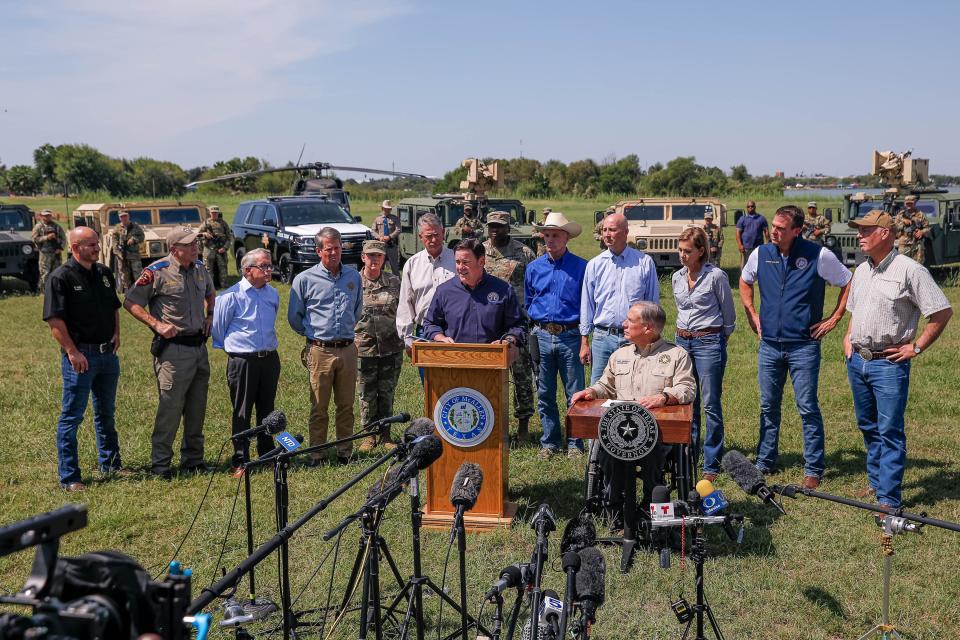
The governor’s office has not provided records on what it claimed as an initial round of drug seizures nationwide.
The Republic had done reporting on the Border Strike Force in 2018 that showed it took credit for drug seizures far from the state’s border with Mexico and for drug seizures measured in fractions of a pound, not indicative of cartel activity.
The Republic sought more records about the Border Strike Force from the DPS beginning in 2019. But the Arizona Department of Public Safety, the agency that houses the Border Strike Force, did not provide the records until the newspaper pressed the public records case in court in 2021.
The voluminous records were released to The Arizona Republic upon a judge’s order. Until then, the DPS had told The Republic that the records didn’t exist.
The thousands of pages of records show in minute detail the day-by-day activities of troopers and detectives who the DPS identified as members of the Border Strike Force.
Rather than illuminate the work, though, the records raised more questions.
The records do not show much in the way of investigative work that looks to dismantle cartels. Much of the trooper activity recorded involves finding drugs during routine traffic stops.
There is nothing in the records to show that the impressive amounts of drugs seized during the seven years of the Border Strike Force would not have been seized with normal trooper activity, bereft of political messaging.
It is also not clear why so many cases identified by the DPS as being Border Strike Force cases did not involve any member of the Border Strike Force.
Nor is it clear from the records what qualified a case to be credited to the Border Strike Force case and have its drug seizures added to the unit’s overall tally. No pattern can be discerned through the records. The DPS, in years of asking, has not provided an answer.
Some county sheriffs had previously suggested to the Republic that the answer was simple: Every traffic stop that involved seizures was credited to the Border Strike Force.
It is also not clear why the DPS had been reluctant to produce records involving the Border Strike Force.
The Republic asked for documents that would provide weekly reports of trooper’s activities. The DPS started providing timecards, but said it had no other responsive records.
After a judge asked the DPS to avow to him they had no records showing trooper activities, the DPS reversed course, saying it had found such records.
One set of documents it produced was called trooper activity reports; the other was called weekly time and activity reports.
Those records show that the Border Strike Force lives up to no individual part of its name.
The Border Strike Force does not concentrate on the border. Only 43% of its listed cases took place in Cochise, Santa Cruz, Pima and Yuma counties, the four that abut Mexico.
The DPS has said the geographic focus of the Border Strike Force includes the counties of Pinal and Maricopa, which includes the metro Phoenix region. It also has “satellite” resources in two eastern Arizona counties, Graham and Greenlee.
Yet, for unexplained reasons, the Border Strike Force has claimed credit for stops in the state’s northernmost counties, including areas that encompass the Grand Canyon and Painted Desert, areas not commonly thought of as the border region.
The Border Strike Force does not strike. Although some operations resulted in impressive drug seizures, there also appeared to be a lot of dry fishing expeditions. One operation, according to the records, involved troopers driving along an interstate, pausing every mile and getting out and looking for illegal activity in the desert. None was observed.
The Border Strike Force is not a force. The Department of Public Safety provided The Republic two sets of records: A list of more than 100 troopers and detectives it said were members of the Border Strike Force and their activities, and, secondly, a log of cases credited to the Border Strike Force. But, an analysis of that data shows, more than half of the cases credited to the Strike Force did not involve any members of the Strike Force.
It is not clear why that is. The DPS would not explain why a case would be classified as a Border Strike Force case if there was no involvement from any members of the Border Strike Force.
It could be that troopers were not diligently logging their activities. The data showed obvious flaws; one trooper ascribed his work to the same case number for several months in a row. It is not clear how often similar oversights were done by troopers on a smaller scale.
The Republic, wishing to understand this anomaly, asked detailed questions about the DPS record-keeping system, wondering if the way some incidents were labeled had them hidden behind others. Information technology experts from the department said they would redouble efforts to check, but doubted any hidden records existed.
A spokesperson for Ducey, C.J. Karamargin said that the benefit of the Border Strike Force was evident in its impressive drug seizures.
"I think most Arizonans would say good job,” Karamargin said. “whether or not they are part of a Strike Force or a trooper whose on a traffic detail.”
The Border Strike Force records released by the DPS show nothing in the way of investigative work following the drug seizures up the chain in an effort to dismantle organized drug cartels.
The highest-profile Border Strike Force stops, including some trumpeted by Ducey at a news conference, resulted in the individuals convicted for transporting drugs receiving jail time measured in months, not years.
The Border Strike Force received relatively little notice in the early years of Ducey’s second term. But Ducey gave it renewed attention in the 2022 midterm elections.
The Republican Governors Association, which Ducey leads, took out ads attacking Katie Hobbs, the Democratic nominee for Arizona governor and eventual winner, for voting against the Border Strike Force while she was a legislator.
Hobbs's no vote was not specifically against the Border Strike Force, but she joined other Democratic lawmakers in voting against the entire state budget as a whole.
On the campaign trail, Hobbs said she appreciated the efforts of the Border Strike Force as a drug interdiction unit, though she said the name was misleading for what its actual mission was.
Overall, the records of the Border Strike Force highlight a seeming contradiction to the political message that Ducey has brayed in press releases and news conferences.
Despite Arizona having a dedicated Border Strike Force since 2015, with financial resources provided by an unquestioning Republican majority in the state legislature, its own statistics show it has failed to fulfill its promise of stemming the flow of illegal drugs or people.
Arizona’s model has proven folly.
Meth on the move
Trooper Howard McDonald’s shift on Sept. 8, 2018, started at 12:28 a.m., according to his trooper activity report. He had an uneventful first two hours. But around 2:20 a.m., while patrolling Interstate 10 in the desert south of Phoenix, his activity report shows he made three traffic stops within 30 minutes.
At 2:58 a.m., McDonald pulled over a 1991 Chevy pickup for a lane violation. It was a traffic stop that would be celebrated 10 days later by Gov. Ducey in a news conference, with the drugs the trooper reported finding placed on a table before reporters, photographers and television cameras.
The trooper, according to court records, thought the truck was traveling “in tandem” with another vehicle. A check of border crossing records showed the two vehicles had crossed the Mexico border at about the same time that day.
McDonald asked the driver if he had anything illegal in his truck, records show. The driver said he didn’t and then, records show, agreed to a search of his vehicle. McDonald noted oddities around the gas tank. A scope placed inside the tank found wrapped packages of methamphetamine inside, records show. The weight of the drugs: 52 pounds.
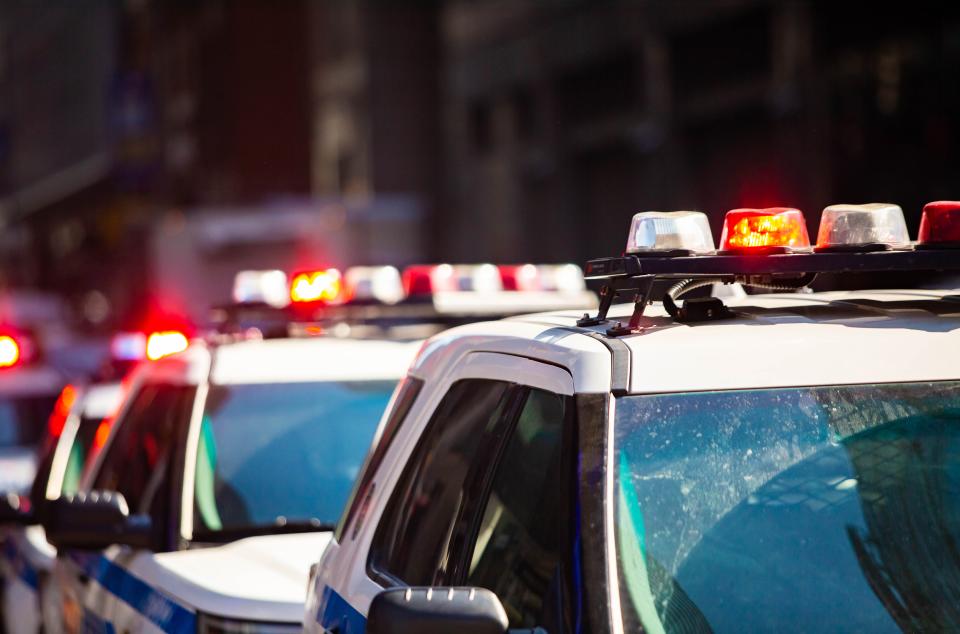
The 19-year-old driver from Rio Rico was arrested.
Four days later, another trooper with a K9 officer made a traffic stop on Interstate 10 near Tucson. That vehicle, according to court documents, was driving too slow. The driver was trembling when handing his identification to the trooper, documents say. The driver agreed to allow a K9 to walk around the vehicle.
In a hidden compartment in the trunk, the trooper found 122 pounds of meth, records show. The 24-year-old driver from Phoenix was arrested.
The next day, Sept. 13, 2018, another trooper with a K9 pulled over a 2005 Mini Cooper in Yuma county and found 50 pounds of methamphetamine and just over a pound of fentanyl pills. An 18-year-old from Yuma was taken into custody.
Although a news release would describe the Yuma stop as a Border Strike Force case, no trooper assigned to the Border Strike Force reported working on it.
Ducey, on Sept. 17, 2018, traveled to Tucson for a carefully staged news conference. The meth seized in the traffic stops was stacked up in plastic bundles on a table to his right. The logo for the Border Strike Force, a snake uncoiling itself to attack, was behind his head.
At the time, some polls showed Ducey was in a tight race with his Democratic challenger for the governor’s office.
At the news conference, the then-head of the DPS, Frank Milstead said that the drugs arrayed in front of him constituted “narcotics terrorism.”
Ducey praised the work of the DPS, saying the work stopped drugs from entering the community and “devastating more lives.” Then, he abruptly left the news conference without taking questions. Reporters gave chase, but Ducey was in his vehicle and being driven away by the time media hit the parking lot.
In a subsequent news release, Ducey described the Border Strike Force combating the “threat posed by drug cartels and human smugglers along our southern border.”
But, despite the tough talk of dismantling cartels terrorizing Arizonans, records show little effort to work up the supply chain and find the ringleaders. These small fish would do.
Of the three, two were sentenced to jail, not prison.
The strongest sentence went to the 18-year-old from Yuma named Martin Borgarin, who had 50 pounds of meth along with some 4,000 fentanyl pills. He was sentenced to 3.5 years in prison.
He entered custody as a minimum security inmate, prison records show. But he was found guilty of a slew of violations behind bars, including fighting and making an intoxicating substance. By the time of his October 2021 release, he was listed as “close” custody, the second highest level possible.
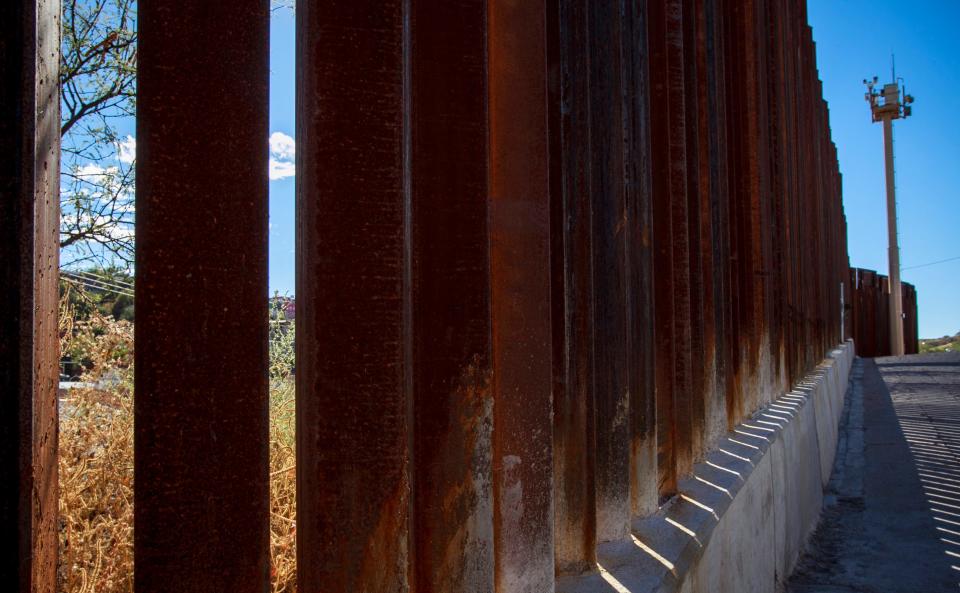
A 19-year-old driver from Rio Rico, Roberto Cervantes, was sentenced to nine months in jail after pleading guilty to a single felony. He could not be reached for comment.
A 24-year-old from Phoenix, Guillermo Parada, who troopers said carried 122 pounds of methamphetamine, pleaded guilty to a felony count of conspiring to transport a dangerous drug for sale.
Records show the married father of two was laid off the month before and this was his first brush with the law. He was sentenced to serve another six months in jail beyond the time he had already done awaiting trial. The judge immediately granted him work furlough.
Reached by phone, Parada said the incident was not something he would want to revisit. He had done his time and was wrapping up his probation. Records show he has made his court-ordered payments, including one in November. “I’m pretty much almost done with everything on my end,” he said.
A Google search of Parada's name still turns up news stories and the DPS news release about his arrest. But, he declined to detail for a reporter how he felt about being the subject of a Ducey news conference.
“I’m not going to answer any question on that,” he said.
Forced to respond
The Republic has faced resistance in obtaining records about the Border Strike Force from the Department of Public Safety.
The Republic started investigating the Border Strike Force in 2018. That year, Ducey was seeking reelection and the efforts of the Border Strike Force figured prominently in his campaign commercials and stump speech talking points.
In 2019, The Republic aimed to follow-up on Border Strike Force activities. In late September 2019, the newspaper filed a public records request asking for an updated log of Strike Force cases.
Although the DPS produced such a spreadsheet in 30 days in 2018, this updated request was not fulfilled until March 2021. And that spreadsheet still only covered cases through Oct. 1, 2019.
The DPS did not initially provide an explanation for its delay in releasing the records.
Additionally, The Republic asked the DPS if there were records that would show day-to-day activities of the troopers assigned to the Border Strike Force. A spokesperson for the DPS, in a phone call and in a subsequent e-mail, said that documents informally called “weeklies” would provide that information.
The DPS started providing records in April 2021. It placed the records on 30 DVD discs and charged The Republic $15 for each one.
But the records it provided were time sheets that simply showed hours worked.
A Maricopa County Superior judge, in July 2021, found that the DPS violated the public records law when it took 18 months to produce an updated spreadsheet. In his ruling, the judge also ordered the DPS to either produce records showing detailed records of troopers’ activities or state that no such records existed.

That same month, the DPS, speaking through an attorney, told The Republic it had located documents that were “significantly more responsive” to The Republic’s request for weekly documents that showed trooper activities.
Those records consisted of two sets of documents. One was called the Trooper Activity Report. Another was the Weekly Time and Activity Report. The agency began supplying those records to The Republic in August.
The voluminous records showed trooper’s daily goings-on in minute detail. Some troopers even included what they had for lunch.
It allowed The Republic to analyze in detail what the troopers the DPS said were assigned to the Border Strike Force were doing.
'No criminal activity reported'
In the early days of the Border Strike Force, troopers would amass and head into the open desert in southern Arizona. Armed with newly purchased equipment from its initial outlay of cash from the Arizona Legislature, troopers would look for drugs being smuggled north.
The Border Strike Force would strike.
The operations were given names. A sampling: No Escape, Organ Grinder, Sidewinder, Rolling Thunder.
Results from those operations made it into Ducey speeches and news releases. For example, a pair of operations named Sidewinder II and Sidewinder III were credited with the combined seizures of 5,084 pounds of marijuana and 52 felony arrests.
Ducey spoke before a U.S. House subcommittee in 2018 about the Border Strike Force and told members about Operation Organ Grinder and its seizure of 4,000 pounds of marijuana and the arrest of 73 felons.
But the activity reports also tell of days of monotony.
One trooper, Brandon Kinser, reported that on Oct. 26, 2016, he worked with the West Desert Task Force along Interstate 8. Records show he was joined by at least three other Border Strike Force members on the 10-hour shift.
During that time, he wrote in his report, “Detectives physically got out at each milepost along Interstate 8 from 147 to 167 to look for any sign of activity. No criminal activity was observed.”
On Nov. 8, 2016, as part of Operation No Escape, law enforcement spotted five men carrying backpacks in the desert, presumably marijuana smugglers. According to his activity report, Kinser and agents from the Bureau of Land Management and Border Patrol and the Pinal County Sheriff’s Office gave chase. “The subjects and marijuana were not located,” he wrote in his report.
The next day, after getting a flat tire repaired, Kinser summed up his day with these words: “No calls, no criminal activity reported.”
The records show that named operations changed in focus and operational control by early 2019. The final Sidewinder operation took place in late January 2019. The Sidewinder operations – they stopped being numbered after the fourth – then became the province of the Pima County Sheriff’s Office.
Operations listed in trooper activity reports from 2019 on seemed more directed at individual investigations. Operation Eagle Eye, for example, involved a business by that name. Operation Finding Niko seemed aimed at a person named “Niko.” One trooper noted on March 26, 2020, that the operation had “captured Niko.”
In 2018, the then-DPS director, Frank Milstead, told The Republic, in an interview, that the Border Strike Force had been constituted to work with its federal partners and patrol the open desert. “Well, our deserts have gone relatively quiet,” Milstead said.
Instead, Milstead said, smugglers had started carrying drugs in vehicles and through the legal ports of entry. The appetite for bulky marijuana had subsided in the illegal market, replaced by smaller drugs, like meth and fentanyl, that were easier to hide in vehicle.
So, according to a Twitter post Milstead wrote in 2018, the vast majority of Border Strike Force activities “happen on the highway, not the desert.”
This mirrors testimony from federal officials who have told Congress and produced official reports saying that, since 2017, more illegal drugs come through the ports of entry, not smuggled through the desert.

According to a report produced by the Drug Enforcement Administration, 88% of the fentanyl seized in 2019 came through legal ports of entry, not in the open desert.
That same report mentioned that Mexican smugglers still did some smuggling using backpackers and couriers in the open desert. But, the report described a common method of smuggling drugs was concealment in passenger vehicles or commercial trucks.
DPS troopers, according to agency statistics, have a long history of seizing an impressive amount of drugs on Arizona's highways, without the need for a dedicated and trumpeted division.
DPS troopers have shown a penchant for detecting potential criminal activity during traffic stops, records show, sometimes acting on tips sent to them from federal authorities.
For example, on January 5, 2016, trooper Kinser stopped a blue Lincoln Navigator that was driving too slowly in the left, or passing, lane of Interstate 10. Kinser knew that federal authorities had told troopers to look a blue Navigator that could be involved in an ammunition smuggling ring.
During the stop, Kinsner saw that the back seat was stacked high with boxes of ammunition used in semi-automatic rifles. Kinser talked with the driver, according to court records, and she didn’t know anything about the bullets she had, talking about them as if they were for pistols, not rifles.
Federal prosecutors would indict the driver, Jessica Soto, and 20 others as part of a ring that sent ammunition to Mexico. Soto pleaded guilty to transferring 26,000 rounds, court records show.
Kinser’s stop was not listed among the cases credited to the Arizona Border Strike Force that were released to The Republic.
Ghost patrols
It is not clear what constitutes a Border Strike Force case.
Ducey, in 2018, attempted to provide a simple answer. “Because a member of the Strike Force pulled them over," he said, during a meeting with the Republic’s editorial board during his reelection campaign.
But, DPS records show, that is not the case for more than half the cases credited to the Border Strike Force.
Another way of putting it: The majority of cases credited to the Border Strike Force don’t involve anyone from that force.
The DPS provided activity reports for troopers and detectives encompassing the time they were assigned to the Border Strike Force. Those detailed reports contained case numbers, or incident numbers.
The DPS also provided a list of cases credited to the Border Strike Force. That list also contained incident or case numbers.
If the Border Strike Force were a discrete force, each case number would be found in a Border Strike Force member’s activity report.
But, a Republic comparison of the two data sets showed that in nearly 60% of cases, no Border Strike Force member reported working on a Border Strike Force incident.
The Republic wanted to make sure it was analyzing the data right.
It analyzed the case management system, studying how troopers would interact with it.
During a phone call with information technology specialists with the DPS, The Republic asked whether certain notations might shield cases behind others. As if there was a parent case, with sub-cases underneath it.
The technicians said they were unaware of any such subsystem, but would explore the issue.
The Republic has not heard back that its analysis was wrong.
The DPS, despite being asked in various forms since 2018, could not provide an answer to the basic question of what constitutes a case being credited to the Border Strike Force.
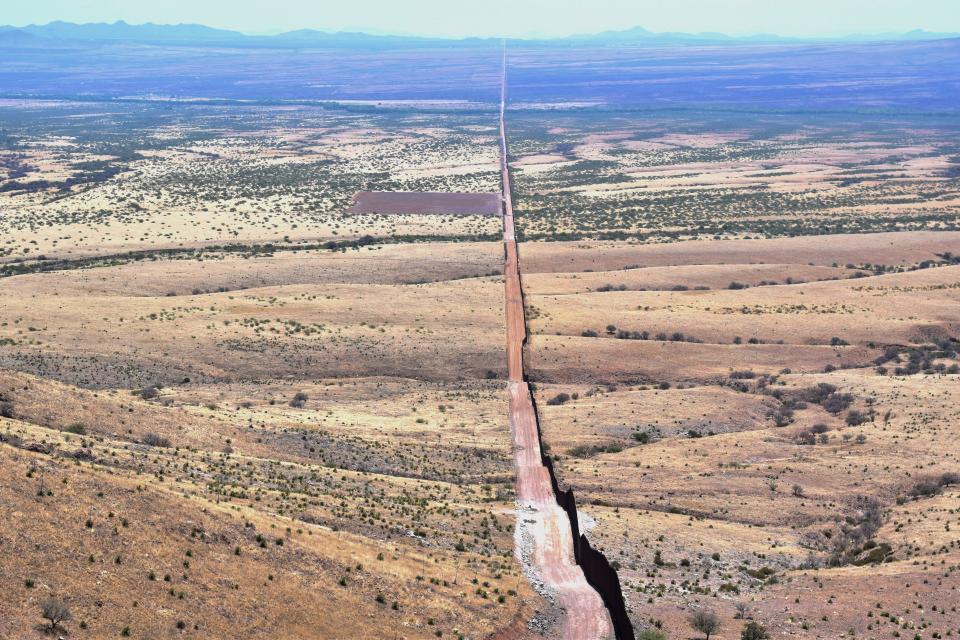
Far from the border
The Border Strike Force does not confine its efforts to the four Arizona counties that share a border with Mexico.
Some of that is by design. A sheet of statistics produced by the Border Strike Force unit described its general operation area as the "central and southern counties of Arizona." It noted "satellite operations" in two counties in eastern Arizona.
Yet, cases on the spreadsheet provided to The Republic veer into northern Arizona counties.
A Republic analysis of the latest data provided to it shows that 39% of Border Strike Force cases, from 2015 through January 2022, took place in Arizona’s four border counties.
That percentage was lowest in the Border Strike Force’s most active years, hitting a low of 34% in 2019.
In 2018, the most active year for the Border Strike Force, based on case count, only 38% of its cases were from border counties.
The Ducey spokesperson, Karamargin, said that the Border Strike Force was meant to protect the entire state. “The illegal narcotics are illegal and lethal no matter where they are,” he said.
Although Ducey was quiet about the Border Strike Force in the years after his re-election, it became a favored talking point again in 2022.
In October, Ducey announced that the American Governors Border Strike Force had conducted an operation that collectively seized more than 7,000 pounds of illegal drugs.
A news release showed the bulk of the drug seizures took place in Oklahoma and Ohio, states that don’t share a border with Mexico. Arizona had a modest amount of drugs seized, according to the legend on a map accompanying the news release. Texas, according to the map, was even lower.
The Ducey administration, in response to a public records request, said it had no documents showing how the governor's office received those figures.
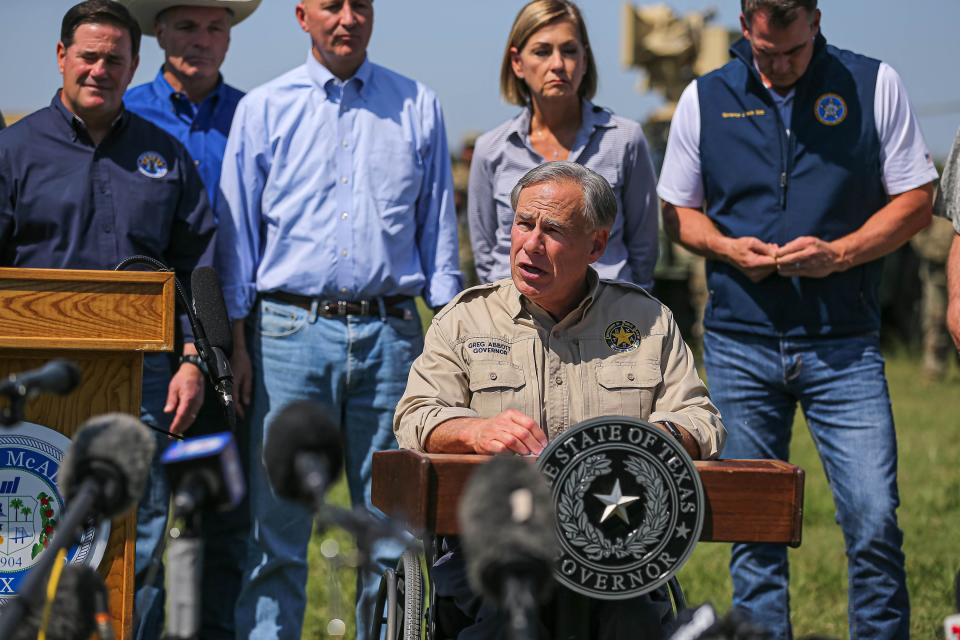
Gov. Greg Abbott of Texas has also made news for his border efforts. He has shipped migrants to states on the East Coast, something Ducey has also done with less fanfare and bombast.
Abbott has also empowered his National Guard to return crossing migrants to the border. That effort has earned him national attention.
And although Ducey announced the American Governors Border Strike Force during an interview on the Fox News Network, his efforts have apparently not resonated with border hawks in the way Abbott's efforts have.
Following a June news conference with Vice President Mike Pence, border officials who served in the Trump administration praised Abbott’s efforts, but had little to say about Arizona.
Rodney Scott, the former chief of the U.S. Border Patrol, said he had not heard much detail about Arizona’s efforts. “I don't think Arizona is doing what Texas does,” he said.
Similarly, Mike Morgan, the former acting commissioner of U.S. Customs and Border Protection said he worked with several Arizona sheriffs and the DPS. But did not seem familiar with the Border Strike Force itself.
“Right now,” he said, “Texas, hands down, is doing more than any other state.”
This article originally appeared on USA TODAY: Arizona's Border Strike Force under Gov. Doug Ducey is a misnomer

